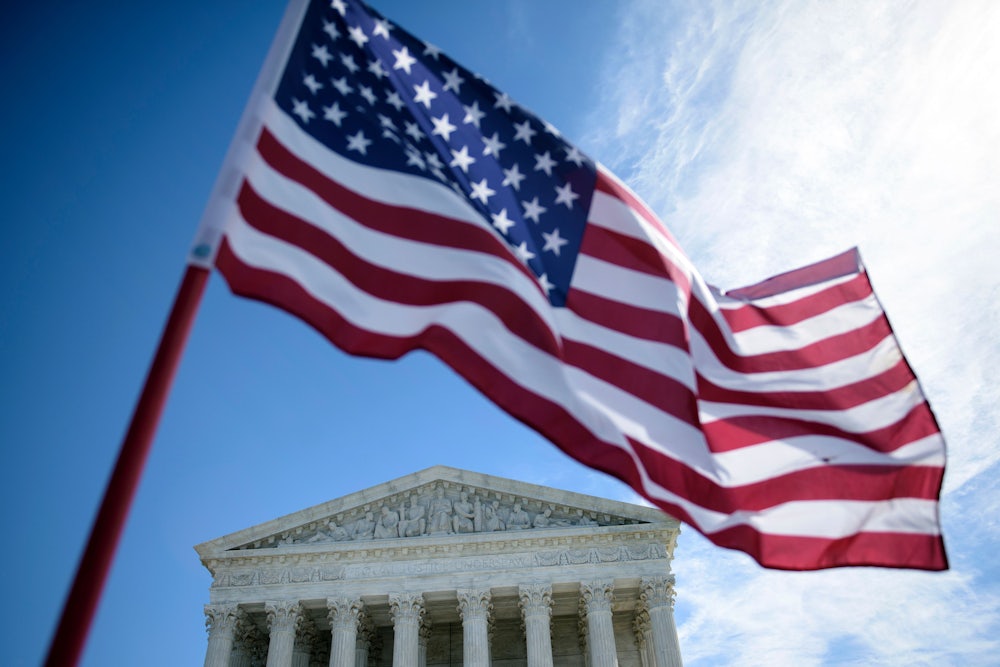Which of these is a substantial burden? A law that results in the closure of abortion clinics and requires women to travel hundreds of miles to exercise their constitutional rights? Or a regulation requiring employers to fill out a form to claim a religious accommodation? This question is at the heart of two of the biggest cases being heard by the Supreme Court this year: one on Texas’s strict new abortion laws, argued earlier this month, and a challenge to the Affordable Care Act and its contraceptive-related provisions that will be discussed at oral arguments today.
In Whole Women’s Health v. Hellerstedt, the plaintiffs argue that Texas’s onerous abortion regulations would destroy the basic infrastructure that women rely on to exercise their constitutional right to abortion. In Zubik v. Burwell, religiously affiliated employers object to filling out a form needed to opt out of the ACA’s contraceptive coverage requirement, claiming that it imposes a substantial and unjustified burden on the free exercise of religion in violation of the Religious Freedom Restoration Act.
When the decisions in these cases are handed down, the Court’s analysis of what kinds of burdens or obstacles are substantial will take center stage. While both cases are expected to divide the justices, the question of substantial burden or obstacle shouldn’t.
In Whole Woman’s Health, the forced closure of more than 75 percent of the state’s abortion clinics—exponentially increasing the burden on thousands of women—is a substantial obstacle by any definition of the term. Thanks to the forceful questioning of the Court’s female justices during oral argument in early March, the state’s medical-based justifications were exposed time and again as mere pretense for a sweeping anti-abortion agenda. States should not have the authority, in the words of conservative law professor Richard Epstein, to “covertly overturn a constitutional decision by imposing high hurdles on the right to abortion that only abortion opponents think necessary for the women whom they wish to deny the right to abortion.”
In Zubik, employers challenging the ACA are asking for an unprecedented expansion of the definition of substantial burden. Religious accommodations—like those contained in the ACA—that allow religious objectors to opt out of their legal obligations and transfer those obligations to third parties are as old as the nation itself. But in Zubik, the employers have attacked the religious accommodation itself as a substantial burden on religious liberty. Even though the accommodation eliminates any role for the employer in the provision of contraceptive services and shifts the burden of paying for such coverage to insurance companies, the employers insist that the requirement that they sign a simple form to claim the accommodation is unlawful.
This claim is so extreme that even those who contend that RFRA should be very broadly interpreted, such as professor Douglas Laycock, have argued that it “tends to discredit RFRA and the cause of religious liberty.” If the government is sued for providing religious accommodations, it will be less likely to enact such protections in the first place. That would be a setback, not an advance, for religious freedom in a nation composed of people of many different religious faiths.
During the oral argument in Whole Women’s Health, the Court’s conservative Justices tried to undermine the argument that Texas’s laws impose a substantial obstacle on women seeking to exercise their constitutional rights. Justice Samuel Alito, together with Chief Justice John Roberts, asked a barrage of questions, seeking to raise doubts about whether the state’s restrictions—among the harshest in the nation—had caused clinics to close or whether women would be unable to obtain abortions.
The Court’s conservative justices, then, should have an easy time rejecting the far-fetched argument in Zubik that religiously affiliated employers are substantially burdened by the requirement that they fill out a mere form.
The real test will come when Zubik is argued on Wednesday. Will we see Justice Alito and others embrace an incredibly protective version of the substantial burden test, insisting that what matters is whether the religious employers sincerely believe that signing the form is inconsistent with their religious beliefs? According to this argument, a burden is substantial if the person claiming to be burdened sincerely believes it is.
That version of the substantial burden test has never been the law. It would eliminate any role for the courts in applying statutory language, and it cannot be squared with the fact that the Supreme Court has in the past rejected such claims because the person pursuing it faced no substantial burden. While courts should not second-guess the content of religious beliefs, they do have a duty to inquire whether a law, in fact, imposes a genuinely substantial burden on the free exercise of those beliefs. Zubik is a test of whether the justices will continue to enforce the substantial burden test, which is reflected in the text of RFRA, or gut it to make it easier for religious employers and others to demand religious accommodations, effectively defining statutory language for themselves. RFRA’s clear language should not be written out of the statute.
Substantial burden tests—which are quite common in the law—require courts to measure a law’s impact on fundamental rights, limiting judicial intervention to cases in which laws deeply intrude on protected liberty. But they are easy to manipulate in a results-oriented way. Reasonable people can differ about what makes a burden substantial, but the analysis shouldn’t depend on whether the justices favor the underlying right, whether it’s religious exercise or reproductive freedom.
